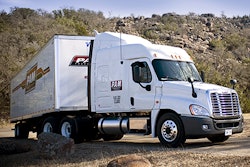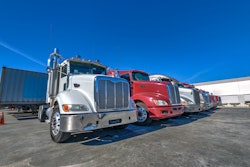Freight markets are once again feeling the pressure of unpredictability. According to the annual Council of Supply Chain Management Professionals State of Logistics report, businesses must prioritize agility, expand sourcing across multiple countries, and lean into AI-driven innovation.
While real GDP rose around 2.7% in 2024, the industry saw flat freight volumes, excess truck capacity and increasing operating costs, particularly labor and fuel, said Korhan Acar, partner at Kearney and the report’s lead author.
U.S. business logistics costs surged to $2.58 trillion in 2024 (up 5.4% from the previous year), representing 8.8% of the country’s GDP. In 2023, U.S. business logistics costs were $2.45 trillion, 8.7% of GDP. It’s notably higher than pre-pandemic norm of between 7.4% and 7.8%.
The report cited a “fragile optimism,” with U.S. GDP growth forecasted between 1.7% to 1.8% However, the Trump administration’s ever-changing tariff policy is the “biggest wildcard."
Trade policy is not only affecting the U.S. economy, but trade partners' economy and global demand, said Paul Bingham, S&P Global, director of transportation consulting, Global Intelligence & Analytics at S&P Global Market Intelligence.
Navigating the fog of tariff uncertainty
“Global corridors in the world will not be the same as before,” said Acar, adding that trade policies will shift sourcing decisions that impact volume and routes and create new set of global flows.
 The need for further supply chain diversification could rise.Kearney
The need for further supply chain diversification could rise.Kearney
Friend-shoring, sourcing options from geopolitically friendly countries, was noted as the top rising tactic (36%) that CEOs are looking into due to geopolitical events.
This was followed by creating parallel supply chains (32%). Acar said an example of this is implementing the China Plus One strategy, wherein companies shift manufacturing and sourcing operations from China to other countries.
Talking about the volatility that trade policies have brought, Andy Moses, senior vice president of solutions & sales strategy at Penske Logistics (CCJ Top 250, No. 12), said the logistics industry has become used to disruptions. “It’s not something to get overly dramatic about.”
“Someone has to stay calm,” added Noel Hasegaba, chief operating officer of the Port of Long Beach. “Our focus has been managing the peaks and the surges."
Migration policy shifts affecting labor market
Labor shortages driven immigration policy will also affect trucking, the authors wrote. “As fewer young people are attracted to trucking positions, retiring labor won’t be replaced at pace,” the report pointed out.
Fleets are increasingly prioritizing English language proficiency when hiring drivers, given the new enforcement efforts of the existing federal CDL language requirements, Bingham said.
At the same time, changes in the U.S. immigration policy are broadly impacting the labor force, Bingham added, effectively shrinking the pool of available workers compared to previous years. “That has a supply and demand impact on the total pool of workers who might have been attracted to truck driving, but who now may face different opportunities and wages in other jobs in the economy.”
[RELATED: New research dives into long-haul trucking's driver turnover problem]
The report also pointed to autonomous trucking as a resolution and crucial in the coming decade.
Motor carrier market conditions and outlook
The trucking industry showed signs of recovery in the latter half of 2024, but global political tensions and new trade policies has since tempered the optimism.
Spot rates for dry van shipments in April 2025 averaged $1.96 per mile, down from $1.99 per mile in April 2024, according to DAT Freight & Analytics. Contracts rates fell to $2.40 per mile.
Despite weak demand and rising costs, especially in insurance and maintenance, the anticipated wave of carrier exits has been more muted. However, there’s been an uptick among smaller fleets as financial strain continued, and profitability sank to its lowest since 2010.
Contract rates were expected to decline further, but Acar noted that many shippers resisted pushing rates lower due to concerns about service quality.
"The latest dry van spot rate from DAT throws some cold water on the hope that pricing conditions are about to swing strongly in carriers’ favor," added Jason Miller, associate professor of supply chain management at Michigan State University and interim chair of the Department of Supply Chain Management.
"I continue to expect any supply shock due to stricter enforcement of driver licensing will have limited impact on capacity at the national level and certainly won’t be as impactful as the implementation of ELDs back in late 2017 and early 2018," Miller said.
Brendan Dillon, senior vice president of global inventory management, transportation & trade at Target, said the company is taking a portfolio approach with carriers, emphasizing long-term partnerships for both affordability and reliability.
The report also added that tariffs may bring new financial pressures, combined with potential declines in freight volume, that will continue to squeeze carrier margins.
"Higher duties on commercial vehicles — more than a third of which are sourced from Canada and Mexico — could drive up equipment costs and lead to shortages, further straining fleets,” the authors wrote.
[RELATED: Rising tariffs drive demand for late-model used trucks, pushing prices higher]
Higher equipment costs could also influence carriers to either extend the life of aging fleets (leading to increased maintenance expenses) or absorb capital expenses to replace vehicles.  Economic policy uncertainty is forecasted to skyrocket to levels only seen over the past two decades at the height of the COVID-19 pandemicKearney
Economic policy uncertainty is forecasted to skyrocket to levels only seen over the past two decades at the height of the COVID-19 pandemicKearney
Tactical moves in an uncertain logistics landscape
With a weak demand environment, higher interest rates and higher inflation, Bingham said they’re advising clients to plan for multiple scenarios. The logistics industry must shift from short-term fixes and consider resilience as a strategic move.
“In a world defined by disruption, resilience is what ensures continuity through agility,” said Acar. “As AI and automation drive down the cost of resilience, the greater risk now lies in standing still.”
Looking ahead, the report anticipates that U.S. logistics and transportation output to grow by 2%. Global logistics market is forecasted to grow to $5.95 trillion by 2030, a 7.2% compound annual growth rate from 2025.













